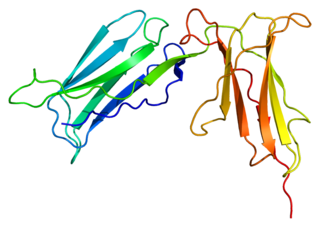Killer-cell immunoglobulin-like receptors (KIRs), are a family of type I transmembrane glycoproteins expressed on the plasma membrane of natural killer (NK) cells and a minority of T cells. At least 15 genes and 2 pseudogenes encoding KIR map in a 150-kb region of the leukocyte receptor complex (LRC) on human chromosome 19q13.4.

The Joining (J) chain is a protein component that links monomers of antibodies IgM and IgA to form polymeric antibodies capable of secretion. The J chain is well conserved in the animal kingdom, but its specific functions are yet to be fully understood. It is a 137 residue polypeptide, encoded by the IGJ gene.

Leukocyte immunoglobulin-like receptor subfamily B member 1 is a protein that in humans is encoded by the LILRB1 gene.

HLA class I histocompatibility antigen, alpha chain F is a protein that in humans is encoded by the HLA-F gene. It is an empty intracellular molecule that encodes a non-classical heavy chain anchored to the membrane and forming a heterodimer with a β-2 microglobulin light chain. It belongs to the HLA class I heavy chain paralogues that separate from most of the HLA heavy chains. HLA-F is localized in the endoplasmic reticulum and Golgi apparatus, and is also unique in the sense that it exhibits few polymorphisms in the human population relative to the other HLA genes; however, there have been found different isoforms from numerous transcript variants found for the HLA-F gene. Its pathways include INF-gamma signaling and CDK-mediated phosphorylation and removal of the Saccharomycescerevisiae Cdc6 protein, which is crucial for functional DNA replication.

Killer cell immunoglobulin-like receptor 3DL1 is a protein that in humans is encoded by the KIR3DL1 gene.

Killer cell immunoglobulin-like receptor 2DL1 is a protein that in humans is encoded by the KIR2DL1 gene.

Killer cell immunoglobulin-like receptor 2DL4 is a protein that in humans is encoded by the KIR2DL4 gene.

Leukocyte-associated immunoglobulin-like receptor 1 is a protein that in humans is encoded by the LAIR1 gene. LAIR1 has also been designated as CD305.

Leukocyte immunoglobulin-like receptor subfamily B member 2 is a protein that in humans is encoded by the LILRB2 gene.

Leukocyte immunoglobulin-like receptor subfamily B member 4 is a protein that in humans is encoded by the LILRB4 gene.

Killer cell immunoglobulin-like receptor 3DL2 is a protein that in humans is encoded by the KIR3DL2 gene.

Killer cell immunoglobulin-like receptor 2DS4 is a protein that in humans is encoded by the KIR2DS4 gene.

Leukocyte immunoglobulin-like receptor subfamily B member 3 is a protein that in humans is encoded by the LILRB3 gene.

Leukocyte immunoglobulin-like receptor subfamily A member 2 is a protein that in humans is encoded by the LILRA2 gene.

Killer cell immunoglobulin-like receptor 3DL3 is a protein that in humans is encoded by the KIR3DL3 gene.
The leukocyte immunoglobulin-like receptors (LILR) are a family of receptors possessing extracellular immunoglobulin domains. They are also known as CD85, ILTs and LIR, and can exert immunomodulatory effects on a wide range of immune cells. The human genes encoding these receptors are found in a gene cluster at chromosomal region 19q13.4.

Leukocyte immunoglobulin-like receptor, subfamily A, member 1 is a protein that in humans is encoded by the LILRA1 gene.

KIR2DL3, Killer cell immunoglobulin-like receptor 2DL3 is a transmembrane glycoprotein expressed by the natural killer cells and the subsets of the T cells. The KIR genes are polymorphic, which means that they have many different alleles. The KIR genes are also extremely homologous, which means that they are similar in position, structure and evolutionary origin, but not necessarily in function.

Paired receptors are pairs or clusters of receptor proteins that bind to extracellular ligands but have opposing activating and inhibitory signaling effects. Traditionally, paired receptors are defined as homologous pairs with similar extracellular domains and different cytoplasmic regions, whose genes are located together in the genome as part of the same gene cluster and which evolved through gene duplication. Homologous paired receptors often, but not always, have a shared ligand in common. More broadly, pairs of receptors have been identified that exhibit paired functional behavior - responding to a shared ligand with opposing intracellular signals - but are not closely homologous or co-located in the genome. Paired receptors are highly expressed in the cells of the immune system, especially natural killer (NK) and myeloid cells, and are involved in immune regulation.

Leukocyte immunoglobulin-like receptor subfamily A member 5 (LILR-A5) also known as CD85 antigen-like family member F (CD85f), immunoglobulin-like transcript 7 (ILT-7), and leukocyte immunoglobulin-like receptor 9 (LIR-9) is a protein that in humans is encoded by the LILRA5 gene. This gene is one of the leukocyte receptor genes that form a gene cluster on the chromosomal region 19q13.4. Four alternatively spliced transcript variants encoding distinct isoforms have been described.








